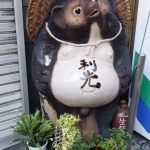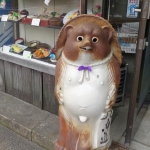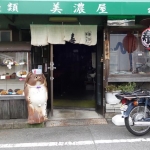Tanuki – Badger
The autumn evening;
It has turned into a Buddha —
The tanuki
–Buson
In Japan, it is common to see some kind of lucky charm in front of business establishments primarily, shops and restaurants. Many Japanese people believe that certain animals bring good fortune and as such they place certain objects resembling these animals at the entrance of their business place.
Many tanuki statues can be found outside shops and restaurants all over Japan. Tanuki statues usually have a big belly and somewhat disproportionate body parts. They are shown wearing turtle shell hats and carrying a promissory note (sometimes replaced by an empty purse) in one hand while the other hand holds a sake bottle.
This animal is supposed to bring good fortune to business because of its 8 special traits:
- The big belly signifies bold and calm decision making.
- The promissory note represents the trust and confidence.
- The bottle of sake represents virtue.
- The big tail represents steadiness and strength.
- Oversized testicles symbolize financial luck.
- Big eyes symbolize the capability to judge the environment and making good decisions.
- The turtle shell hat symbolizes readiness and protection against bad weather (meaning bad times).
- The friendly smile which supposedly means friendly attitude towards customers.
The disproportionate size of the belly, tail, eyes and testicles give the “tanuki” a comical and humorous appearance. The Japanese folklore has many stories related to the tanuki. The tanuki is generally reputed to be mischievous and funny and at the same time gullible and absentminded.
The comical image of the tanuki having a large scrotum is thought to have developed during the Kamakura era, where goldsmiths would use the pelts of tanuki for the process of hammering gold nuggets into leaf. Due to the actual wild tanuki has disproportionately large testicles, a feature that has inspired humorous exaggeration in artistic depictions, and how gold nuggets share a homophone with testicles in the Japanese language, such associations would come to link them together into its folklore image tradition of being a creature of wealth and whimsy. Tanuki may be shown with their testicles flung over their backs like travelers’ packs, or using them as drums. As tanuki are also typically depicted as having large bellies, they may be depicted as drumming on their bellies instead of their testicles — particularly in contemporary art
Most tanuki statues are Shigaraki-yaki, a type of ceramic ware made in and around the town of Koga in Shiga Prefecture. According to the association of local pottery manufacturers, the now familiar design of a cheerful, slightly goofy-looking tanuki, often carrying a flask of sake, was developed by Tetsuzo Fujiwara, a potter who moved to the area in 1936 and devoted the rest of his career to tanuki statuary. In 1951, on the occasion of an imperial visit, the town prepared a special row of flag-waving tanuki statues. Emperor Hirohito was so charmed by this welcome that he penned a poem about it. That was a story the media couldn’t resist, and the resulting publicity contributed greatly to the popularity of the statues.





